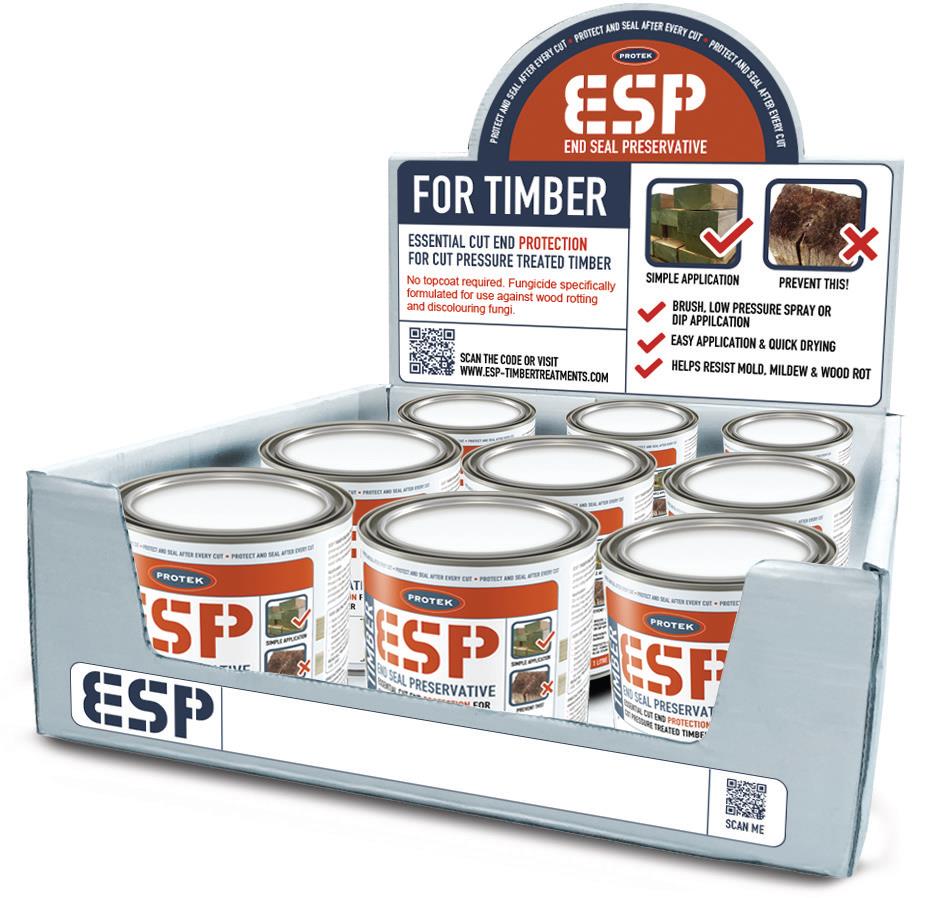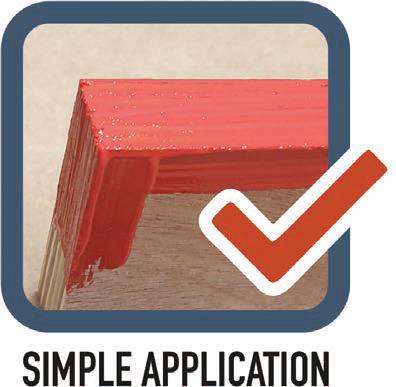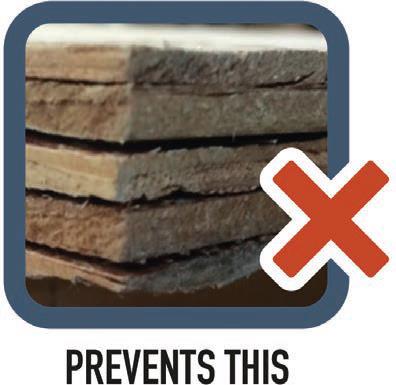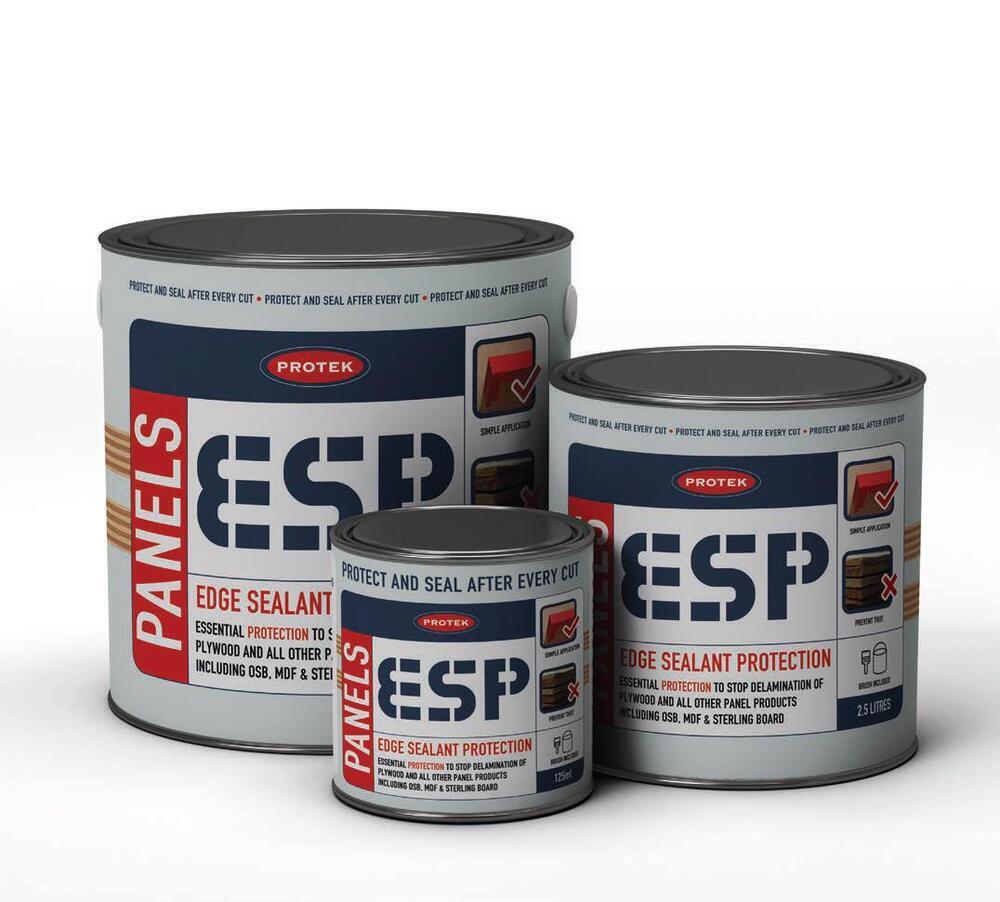ESP gives plywood the edge
29 May 2023WBPI talks to Phil McCormack at Nicks Timber in the UK about the development of ESP, an edge sealant for panel products
WBPI: WHAT IS ESP AND WHAT LED TO ITS DEVELOPMENT?
Phil McCormack: If you go back 20 years the UK imported very little sheet material from China, with nearly all plywood imports coming from Indonesia, Malaysia and Brazil to a grade and standard that had been established over many years. Exterior plywoods were sold to a WBP grade that worked, with sheets being able to be put out in the weather without protection that would not delaminate and still give a longevity of service.
When China entered the market, as with many products from that part of the world, the plywood may look the same, but the manufacturing methodology and the controls put on that process to maintain an acceptable constant standard of end product just didn’t exist. Now, with more than 2,000 factories, China produces the majority of the world’s needs for this product sector.
Suppliers, mainly the merchant sector, started to have problems of delamination due to the failure of the glue line and core gaps – small air pockets, which allows water to get into the board and cause delamination. Market forces, (some Chinese plywood is a lot cheaper), committed the industry to find a solution and for over a decade the advice has been “you must now seal the edges to get performance on exterior grades”. The problem was, there wasn’t a product on the market that could be recommended to achieve this, so when asked “with what?”, the usual retort is old paint, varnish, PVA glue – none of which offer a very satisfactory solution.
After a visit to a major development where the cost to put right a delamination problem was going to be around £1m, plus the increasing specification by architects for marine grade after they had lost faith in exterior grade to do the job, I decided that we needed to take responsibility and solve the problem that was giving all plywood a bad name.
WBPI: WHAT WAS THE R&D PROCESS; WHO HAVE YOU WORKED WITH; AND WHAT CHALLENGES DID YOU FACE?
PM: Frankly it was never really our intention to get directly into the supply chain, merely to drive others already in the sector to see the potential and create the product to solve the problem. We started by approaching the market leader in tinned timber treatment products, but they didn’t seem to want to engage. In the end we went looking for an independent like-minded company and found Protek Ltd. Based in Somerset, UK it is a second-generation family business with an industrial chemist as managing director. It took little persuading as to the need and the market for such a product and so the partnership was formed to jointly develop the ESP range for both Panel and Timber End Seal to resolve a similar rotting issue on cut end pre-treated timber.
Once a product was developed, we both independently tested the new product at our premises with the tried and tested “bucket test” and panels being left out in the weather in a controlled environment test with untreated and treated boards. Our next-door neighbour was repairing a large sign hoarding, so we asked them to use the product as it was going to be left for a year before being used. Vertically exposed, a year on there is still no sign of a problem.
It was during these tests that we accidentally got two boards too close together and discovered an extra benefit. We designed the product to change colour as it dries from light to dark red – this was to aid with handling – but we discovered that if you put two boards together while the edges are still wet, they stick, creating a water tight joint that cannot be broken. This has huge benefits for flat roofs, sarking, dormer cheeks, site hoarding – the list goes on and on. Once we had convinced ourselves we had a product that worked we sent all the information up to BM TRADA for formal testing.
We supplied plywood from our own stock, which we purchase from an approved importer. BM TRADA tested the plywood prior to applying the product to make sure it was to grade and the test plywood failed the pre-test on glue line.
We arranged for further sheets to be sent to BM TRADA from a builders merchant who, like us, believed that it was purchasing “better grade accredited plywood”. This also failed the pre-test but on the fibre strength.
This confirmed what we believed, which was that plywood in the UK has an inherent problem. We instructed BM TRADA to go ahead, using the plywood supplied even though we knew it was below grade. If ESP worked on this product then we knew we had solved the problem and created something that put us back to a WBP grade material.
Needless to say, the BM TRADA test results proved that ESP Panel makes softwood and hardwood plywood exterior again – and it works on OSB for jointing. We could now move forward to market.
WBPI: HOW BIG IS THE MARKET FOR ESP AND WHAT PROGRESS HAS BEEN MADE SO FAR?
PM: Protek has dealt with the chemistry and manufacturing issues and the installation of the new equipment needed to produce and package a product that is of a different texture to its other products.
Nicks has taken care of the testing through BM TRADA and will be responsible for taking this product to market through its current extensive builders and merchant client base.
Nicks has separated this from its core business and Protek has set up a subsidiary company to manage the project through which ESP will be sold and supplied. The new company is Protek ESP Ltd.
The market is huge with nearly 27 million sheets sold in the UK each year.
Major importers such as International Plywood and Altripan have already engaged by recommending their clients use ESP.
Merchant chain Travis Perkins is currently going through the process of getting ESP on the shelf with the recommendation at point of invoice on every plywood sale that it is required to achieve performance. This protects the supplier against complaints when recommended site practice is not used.
Independent merchants Covers and Elliots are now stockists and obviously Nicks has been selling it for the past nine months as an easy extra sale with both plywood and OSB.
We have had only positive comments back from everyone we have approached from “we have needed something like this for a long time”, to “this is a no brainer” – and this is at point of sale before we engage with the architect and design end of the food chain.
It seems that it will also find its way into markets we have not even anticipated. For example, it has been used for quick temporary repairs on flat roofs, and a kitchen fitter has started to use it to seal the holes drilled to take taps in worktops so that water stops getting in and blowing the chipboard core. Its ability to form a watertight joint between boards also makes it a must on OSB when used for roofing projects. So, the market is ever expanding.
WBPI: HOW DOES ESP ENCOURAGE ARCHITECTS TO SPECIFY EXTERIOR PLY INSTEAD OF MARINE PLY?
PM: There has been a noticeable shift, not only by architects but by the larger users of plywood, away from standard exterior grade plywood and into the higher grade more expensive productions. The problems of the general UK panel stock are less likely to occur here, but it greatly increases the cost of the end product – even in something as basic as site hoarding – when trying to avoid the cost of repair and replacement. ESP ensures that exterior grade plywood performs in an exterior setting and that performance and longevity is as it used to be when our stocks were FE WBP and for as little as £1.50 sheet on 18mm.
There has been a noticeable switch by architects from exterior grade plywood for marine in an effort to avoid the problems they have experienced on exterior grades and, again, this greatly increases the build costs. We hope that when they know about ESP they will go back to specifying correctly on exterior grade, which, with ESP Panel applied is a viable option once more.
WBPI: HOW IMPORTANT IS EDUCATION AT A MERCHANT/BUILDER LEVEL IN GETTING TRADESMEN TO PURCHASE CORRECT PLYWOOD PRODUCTS AND TREATMENTS AND WHAT EFFORTS ARE THE COMPANY AND TRADE BODIES MAKING TO BRING ABOUT GREATER AWARENESS? CAN SUPPLIERS/BUILDERS HELP REDUCE THEIR LIABILITIES BY MAKING THE CORRECT CHOICES?
PM: The whole ESP Panel and ESP Timber project has been driven to protect the reputation of timber products by ensuring their performance meets the expectation of architect and end users, otherwise we open the door to non-timber products as substitutes.
Education is the key to moving forward on correct specification at point of purchase and good site practice giving the product the best chance to perform. As chair of the Timber Development UK (TDUK) committee responsible for timber trading standards, we are focused on the need to identify the problems and resolve them where we can and then educate on “best practice” to make sure the correct material is matched to the right end use and that the site requirement to “treat” the product is met.
In my opinion this is as much the responsibility of the seller as the buyer. Merchants need to be asking “what is this being used for?” so they can match the right product to the right end use and avoid problems and costs down the road.
Literature is now being produced by Timber Development UK that will help with this process, and we are working on a modular training programme on all things wood.
WBPI: ANOTHER ESP PRODUCT – ESP TIMBER – IS ALSO ON SALE. HOW HAS THIS BEEN PERFORMING IN THE MARKET?
PM: When I talk to architectural students about timber treatments it’s now a lot more detailed than “does it require treatment or not?” It’s now matching the right Use Class of treatment – UC2/3/4 – to the right species and treatment cycle for where that timber is going to be used.
Again, the crucial question when selling timber products is “What is it being used for?” – but if that pre-treated timber that is now the staple diet of most builders merchants’ stock holdings then has the end trimmed off to fit and that end is not then retreated on site, you may as well have not bothered buying treated timber.
TDUK is very focused on the education of correct specification at point of order on treated timbers. Articles and information are going out to architects and merchants alike to try and get the message across so that we can avoid timber getting a bad name on performance due to the right product not being supplied treated and fitted in the correct way.
An end seal product has been on the market for years and has never sold in the volumes that it should, which only confirms that builders are not re-treating when they cut or drill pre-treated goods. As a result, the main producer removed it from sale two years ago.
We have developed ESP Timber alongside ESP Panel so that merchants can promote good practice and get an extra sale with every panel and treated timber order.
I personally feel that, in an ideal world, merchants should educate on invoice by recommending those products and practices that are required to make their products perform correctly and as required. And on larger jobs, have the product supplied as part of the order. If the contractor doesn’t apply it and there is a problem as a result, the responsibility is not then with the merchant but with the builder for poor site practice.
We have been telling clients what is required for a decade but without a product to recommend that will do the job. Now there is ESP you can with confidence point your customers in the right direction, make an extra sale and, most importantly, avoid claims and complaints.




